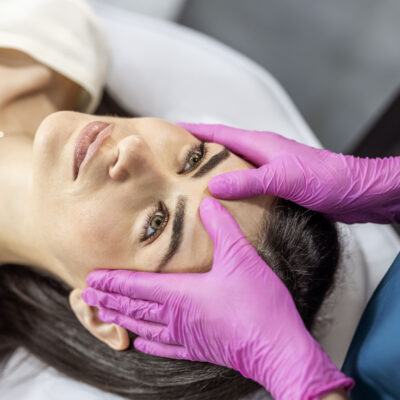We are moving at the speed of light into the future, and what we have on the horizon are remixes and upgrades of the powerful innovations we have now. These up-and-comers aren’t household names, but they promise to deliver swift transformations with major payoffs. As these beauty breakthroughs make their way into treatment rooms, we take a giant leap into a new era of facial rejuvenation. Are you ready for it?
Featured Experts
- Kenneth Beer, MD is a board-certified dermatologist in West Palm Beach, FL
- Robert Singer, MD is a board-certified plastic surgeon in La Jolla, CA
- Ozan Sozer, MD is a board-certified plastic surgeon in El Paso, TX
- Michael Kane, MD is a board-certified plastic surgeon in New York City
- Lesley Clark-Loeser, MD is a board-certified dermatologist in Davie, FL
New Line Erasers
What they are
We are hearing that there are three new injectable wrinkle relaxers coming soon. These new neurotoxins are in development and are said to have some major differentiators that set them apart from what’s currently available.
How they differ: The first neurotoxin creating significant hype is Bonti by Abbvie. It represents a new botulinum toxin type, Type E. “There are different types of botulinum toxin, and the one we’ve been using for decades is Type A,” says West Palm Beach, FL dermatologist Kenneth Beer, MD. Dr. Beer says that with Bonti, we can expect a very fast onset, providing visible results within 24 hours. This makes it a good choice for big events or special occasions. “It has a lot of potential. You can erase lines the day before a big event. However, its duration is shorter, lasting around two to three weeks, so it’s a very temporary result,” adds Dr. Beer.
Another innovation coming soon is a liquid neurotoxin by Galderma, known as a relabotulinum toxin A. New York plastic surgeon Michael Kane, MD says the benefit is mostly for the injector, but results from the liquid formulation are promising. “The benefit is that the injector will not need to reconstitute the toxin, eliminating possible errors. [Reconstitution means mixing the neurotoxin, which usually comes in a powder form, with saline prior to injection to make it a liquid.] However, we’ve seen it has strong potency and a robust duration profile.”
You can erase lines the day before a big event.
Kenneth Beer, MD
Letibotulinumtoxin A is another newcomer that has already been approved in Canada and Europe. Dr. Kane says Leti shows a substantial duration of about 18 weeks. “A repeat injection study, meaning the subjects were treated again and again, showed prolonged results over time,” he notes.
Laser Tightener
What it is: Known for providing a range of treatments from a light, lunchtime laser to a deeper, more resurfacing treatment, the UltraClear laser has a new application called laser coring. The treatment uses a unique wavelength to remove tiny columns of tissue from the skin. This process both removes tissue and delivers energy from the laser to remodel remaining skin, stimulating collagen and elastin production.
How it is done: “Laser coring differs from traditional mechanical micro-coring because it removes slightly smaller cores of tissue while also delivering controlled energy into the skin,” explains Davie, FL dermatologist Lesley Clark-Loeser, MD. “It is approved for patients of all skin types. The primary demographic is individuals with signs of skin laxity, usually ages 40 and up. Additionally, it can also used in the treatment of scars from acne, surgery or trauma.”
How it differs: “Because the cores are tinier than micro-coring, laser coring lends itself to be a little bit more comfortable for the patient and doesn’t require as much pain management or control,” she adds.
“Gliding” Lifts
What it is: While not a new technique, you may have noticed facelifts on your news feed recently displaying visible sutures that resemble crude stitching done on a doll. These “gliding” facial procedures involve repositioning the skin, tissue and muscle using quilting sutures, commonly referred to as a “hemostatic net.” While sometimes unsettling to look at, these quilting sutures play a role in ensuring the stability of the lift, although the procedure can also be done without them says La Jolla, CA plastic surgeon Robert Singer, MD.
How it is done: The “gliding” technique is often referred to as a “scarless facelift,” but it does require small incisions concealed in the hairline. “While gliding techniques can be applied to various parts of the face, the most popular procedures are ‘gliding periorbital shaping,’ ‘gliding browlift’ and the ‘gliding facelift.’ These are typically performed through tiny hairline incisions or hidden incisions within the hairline,” says El Paso, TX plastic surgeon Ozan Sozer, MD. “This procedure is often chosen by younger patients who are concerned about the scars associated with traditional facelifts. A ‘gliding facelift’ typically does not involve the removal of skin. Instead, the deep plane of the face is elevated and the skin is draped vertically using surgical netting.”
How it differs: The “gliding” part relies on the suture technique which prompts the skin to re-adhere to the muscle in a higher position.

















